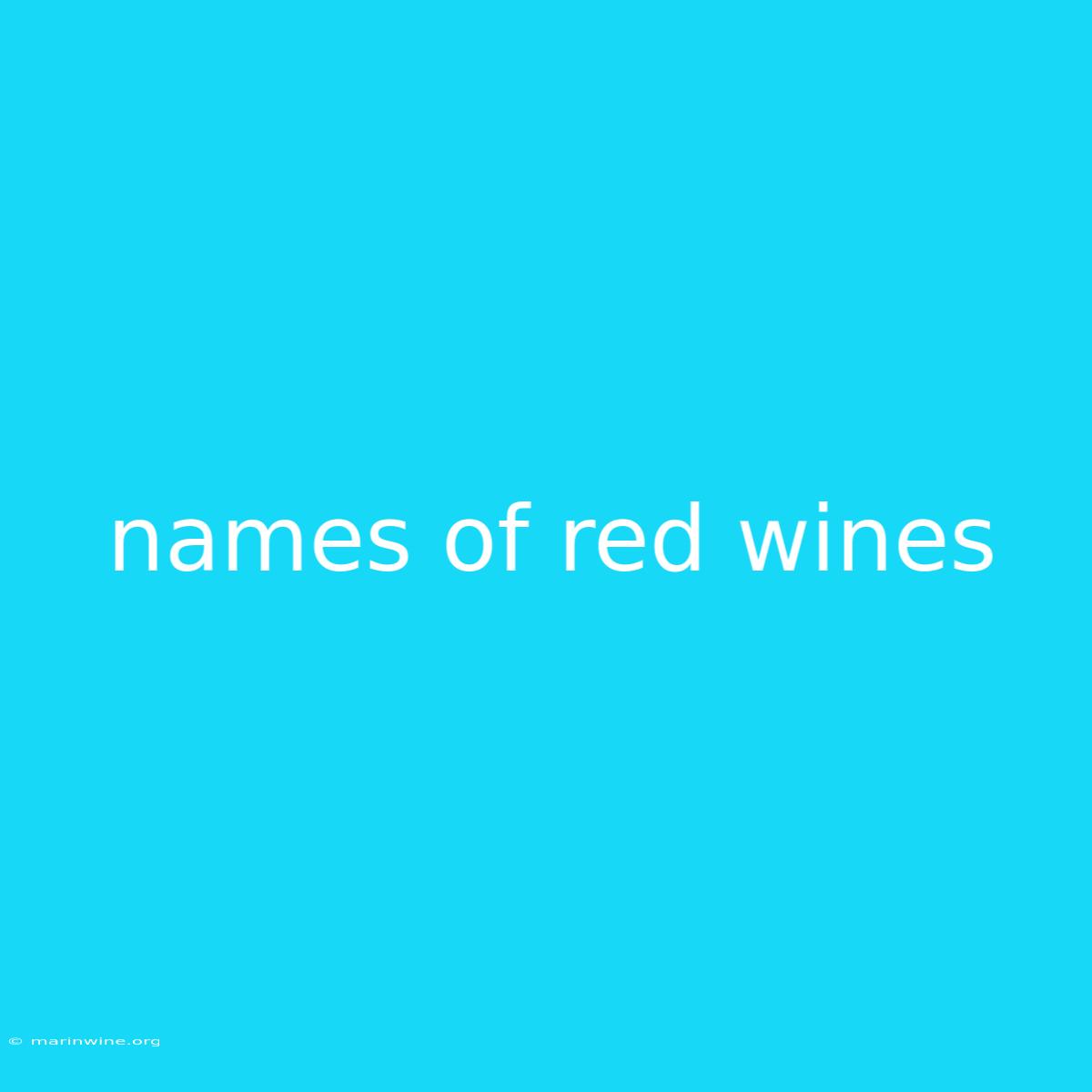The Deep, Rich Palette: Exploring the Names of Red Wines
Have you ever wondered why red wines have such unique and evocative names? It's more than just a label; these names often tell a story about the grape variety, the region, and the winemaking tradition itself. Let's delve into the fascinating world of red wine names and uncover the secrets behind their captivating appellations.
Why It Matters: Understanding red wine names is key to appreciating the diversity and complexity of this beloved beverage. It unlocks a world of knowledge, allowing you to navigate wine lists with confidence and make informed choices based on your personal preferences.
Key Takeaways of Red Wine Names:
| Category | Key Takeaway |
|---|---|
| Grape Variety | Many red wines are named after the dominant grape used in their production, offering a direct insight into their flavor profile. |
| Region | Some wines bear the name of their region of origin, showcasing the unique terroir and winemaking techniques that contribute to their character. |
| Style | Certain names, like "Cabernet Sauvignon" or "Merlot," are associated with specific styles, providing clues about the wine's body, tannins, and aging potential. |
Red Wine Names: A Deeper Dive
Grape Variety Names
The most common way to name a red wine is by the primary grape used in its production. Here are a few prominent examples:
- Cabernet Sauvignon: Known for its bold tannins, rich fruit flavors, and aging potential, Cabernet Sauvignon is a staple in the wine world. Its name reflects the grape's lineage, combining "Cabernet Franc" (a parent grape) and "Sauvignon" (meaning "wild" in French).
- Merlot: Renowned for its softer tannins, smooth texture, and approachable fruitiness, Merlot is often a more accessible red wine. The name itself is derived from the French word "merle," referring to the blackbird that is said to be drawn to the ripe grapes.
- Pinot Noir: This elegant, delicate red wine is known for its bright fruit flavors and earthy complexity. The name translates to "black pine," a reference to the grape's small, dark berries.
Regional Names
Red wines are often named after their place of origin, highlighting the unique characteristics of the terroir. Some examples include:
- Bordeaux: This renowned French region is famous for its Cabernet Sauvignon-based wines, which are typically full-bodied, complex, and age-worthy.
- Burgundy: Another famous French region, Burgundy produces Pinot Noir wines with a distinct, earthy elegance, characterized by their light body and delicate flavors.
- Rioja: This Spanish region produces full-bodied wines from Tempranillo grapes, which are known for their bold tannins, rich fruit flavors, and aging potential.
Styles and Blends
Some names refer to specific wine styles, such as:
- Shiraz/Syrah: These full-bodied wines are known for their intense fruit flavors, peppery notes, and often high tannins.
- Zinfandel: These wines can range in style from fruit-forward and approachable to bold and complex. They are often characterized by their spicy notes and high alcohol content.
Beyond the Name: Exploring the Story
The name of a red wine is just the beginning of its story. Researching the vineyard, the winemaker, and the production techniques can deepen your understanding and appreciation for the wine's unique character.
FAQ for Red Wine Names
Q: How can I tell the difference between a grape variety name and a regional name?
A: Look for clues in the name itself. Grape variety names often have a French origin, while regional names may reflect the language or culture of the specific region.
Q: Do all wines named after a specific grape taste the same?
A: No. The terroir, winemaking techniques, and even the vintage can influence the taste of a wine, even if it's made from the same grape.
Q: Are there any red wines that aren't named after their grape variety?
A: Yes, some wines may be named after a specific vineyard, a historical figure, or a unique blend.
Q: Is there a specific way to pronounce red wine names?
A: While there are general pronunciation guides, the best way to learn is by listening to experts or looking up the correct pronunciation online.
Tips for Learning Red Wine Names
- Start with a few favorites: Explore the names of red wines you already enjoy and investigate the grape varieties and regions associated with them.
- Attend wine tastings: Tasting events allow you to sample a variety of wines and connect their names with their flavor profiles.
- Read wine blogs and articles: Many online resources offer detailed information on red wine names, styles, and regions.
- Use a wine app: Download a wine app to learn about specific wines, explore wine regions, and create your own wine lists.
Summary of Red Wine Names
Red wine names offer a window into the fascinating world of winemaking. By understanding the grape varieties, regions, and styles associated with different names, you can make more informed choices about the wines you enjoy. So, the next time you order a bottle of red, take a moment to appreciate the story behind its name. It's an adventure waiting to be discovered!

